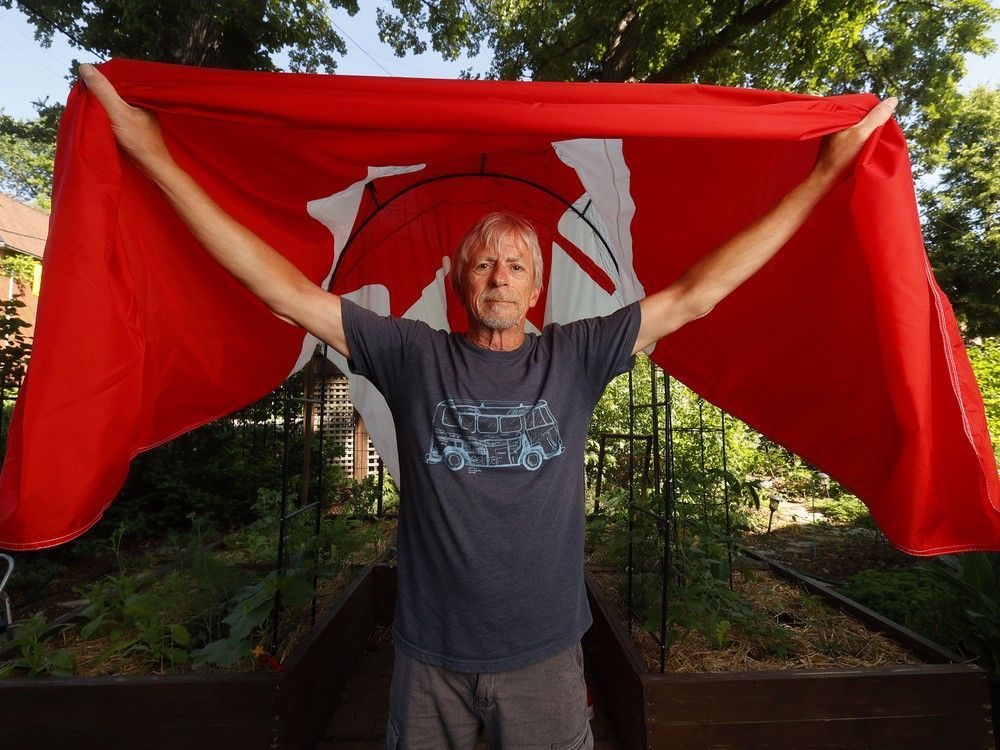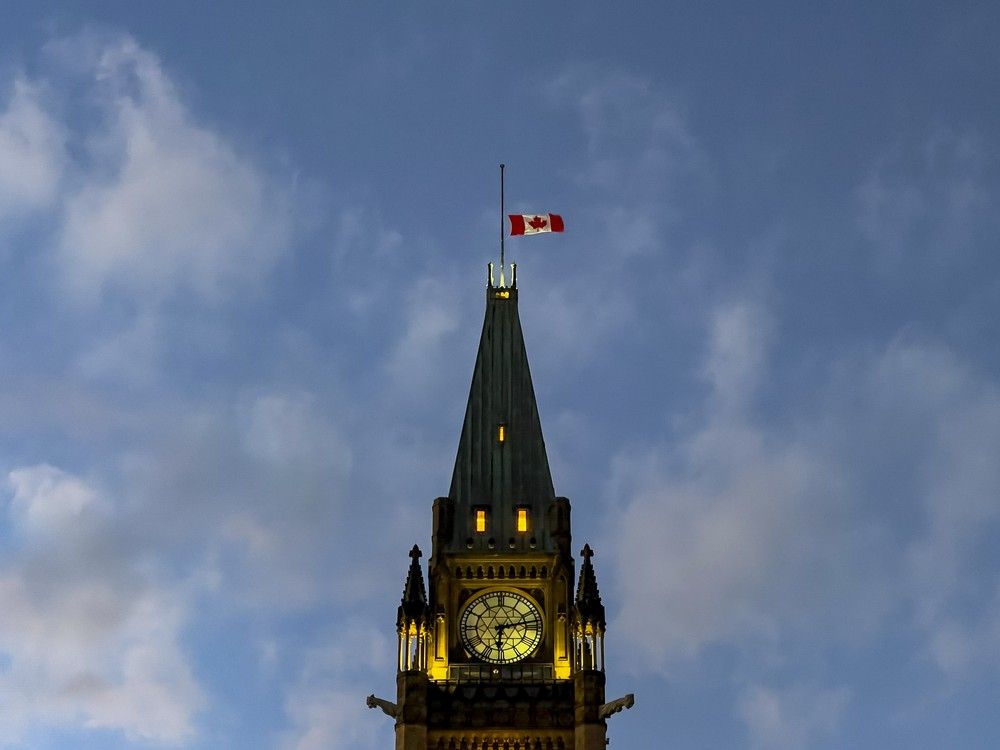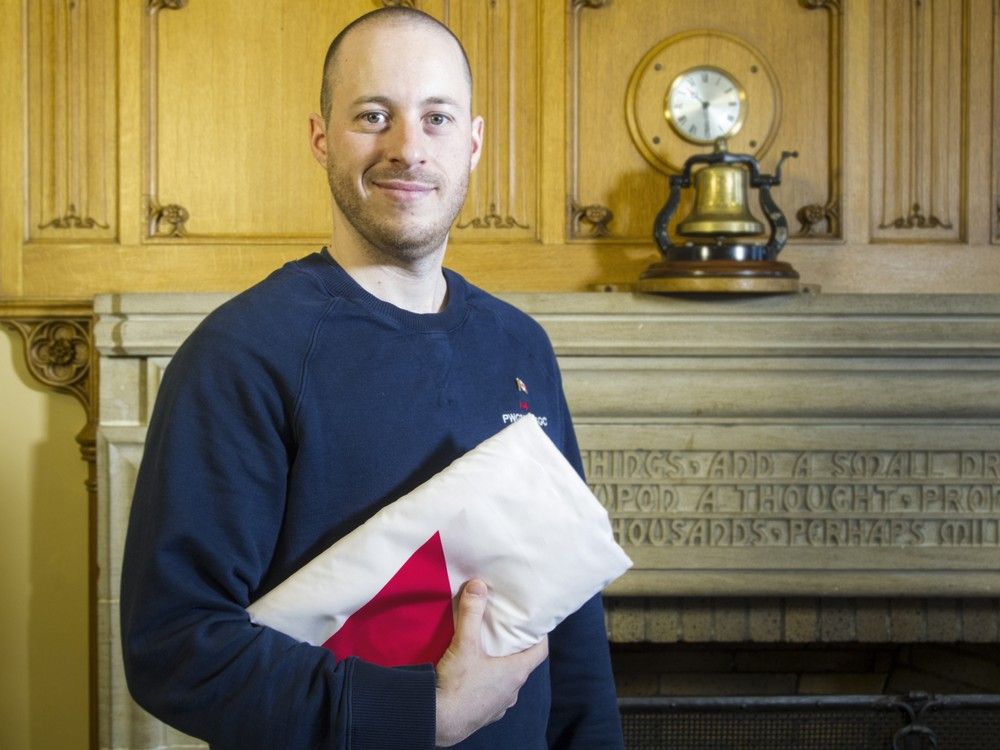
Applying to the federal government for a Canadian flag that once graced Parliament Hill is now an act of extraordinary optimism – or intergenerational foresight.
Public Services and Procurement Canada says the wait list for a Peace Tower flag now extends more than 100 years.
That means it’s now vastly easier to land season’s tickets to the Green Bay Packers (40-year wait) or Manchester United Football Club (25-year wait) than it is to secure a Maple Leaf flag from Parliament Hill.
Winnipeg’s Richard Dyrkacz, 41, applied for a flag in May – even after learning it will be the next century before one arrives in the mail. Dyrkacz thought the wait list might be 30 or 40 years, and was shocked to learn he’s unlikely to see the day he can raise his Parliament Hill-flown flag.
“Let’s be honest, I probably will not live to 140,” he said in an interview. “But I was thinking, ‘If I have kids or grandkids, it will be a nice legacy that could be passed down to them.’
“I’m proud to be a Canadian citizen, and I think it would be a really cool, symbolic gift to give that to your grandkids, or great-grandkids.”
Earlier this year, the Canadian flag celebrated its 60th birthday: It was first raised atop the Peace Tower on Feb. 15, 1965.
Then Prime Minister Lester B. Pearson marked the occasion – a symbolic graduation from British dominance – with a Parliament Hill speech.
“Under this flag,” Pearson said, “may our youth find new inspiration for loyalty to Canada, for patriotism based not on any mean or narrow nationalism, but on the deep and equal pride that all Canadians will feel for every part of this good land.”

The red-and-white Maple Leaf replaced the Canadian Red Ensign, which featured the Union Jack and Canada’s coat of arms.
Pearson’s speech also marked the end of a bitter, sometimes ugly debate over the design of the new flag, introduced as Canada approached its centennial. Conservative leader John Diefenbaker wanted the new flag to reflect Canada’s British heritage, while Pearson argued for a forward-looking design that eschewed the country’s colonial past and did not inflame Quebec nationalism.
The Maple Leaf’s clean and simple design proved a popular, durable symbol of the Canadian identity.
The demand for Parliament Hill flags is one expression of that fact.
In 1994, the federal government launched a program that allowed ordinary citizens to request a flag used on Parliament Hill. They could receive either the Peace Tower flag or one of four smaller flags that fly above the East and West Blocks, and elsewhere on the Hill.
The program quickly gained popularity among Canadians, who could request a flag simply by entering their name and address online.
Initially, it took about four years to receive a Peace Tower flag. By 2015, the wait was up to 48 years. One year later, it was 59 years. The wait list for other Parliament Hill flags was considerably shorter.
As word continued to spread about the free flag program, requests continued to pour in such that the wait time for all Parliament Hill flags has since vaulted beyond the century mark.
“Throughout the years, the popularity and visibility of this initiative have continued to grow, largely thanks to media coverage and social media posts,” said Michèle LaRose, a spokeswoman for Public Services and Procurement Canada.
Requests for flags, she said, usually spike around Canada Day and National Flag of Canada Day.
Ottawa’s Stu Rathbone, a former member of the Canadian Armed Forces, received his Peace Tower flag in 2020 – 14 years after putting in his request online. When he applied in 2006, he was told the wait would be 17 years, but his flag appeared three years early in a plain Purolator package.
“At that time, I think I had seen an article – it might even have been in the Citizen – saying that people could apply for the flag. So, I just applied for it,” he said. “When it showed up, I remember thinking, ‘What’s this? I didn’t order anything.”
Rathbone, 62, who now works as an IT specialist for a Kanata high-tech firm, said he keeps the flag in a shadow box, and takes it out for special occasions.
He considers it one of his most precious keepsakes. “It’s an iconic flag,” he says. “I don’t know if there’s one single flag that gets more pictures taken of it than the one sitting on top of Parliament Hill. It’s just an honour to have it.”
Rathbone plans to submit flag requests on behalf of his grandchildren.
Parliament Hill flags are a limited commodity.

Every weekday, Robert Labonté, a bureaucrat known as the Parliament Hill flag master, changes the flag over the Peace Tower. It means the flag is replaced about 250 times a year. The other Parliament Hill flags are replaced once a week. All of the flags are replaced after being flown at half-mast.
Once removed, each flag is carefully dried and folded before being sent to the next person on the long list of applicants. Each flag has a serial number, and every flag recipient receives a letter describing the date on which their flag flew on Parliament Hill.

Winnipeg’s Richard Dyrkacz, a mechanical engineer and medical doctor, faces a multi-generational wait for his Parliament Hill flag – something he regards as a small, patient act of patriotism. Dyrkacz studied in Los Angeles for two years and was delighted to return home.
“It’s a million times safer here, and people have respect for different people’s backgrounds,” he says. “We have universal health care, a democratic nation, and the opportunity to pursue whatever you want in life.”